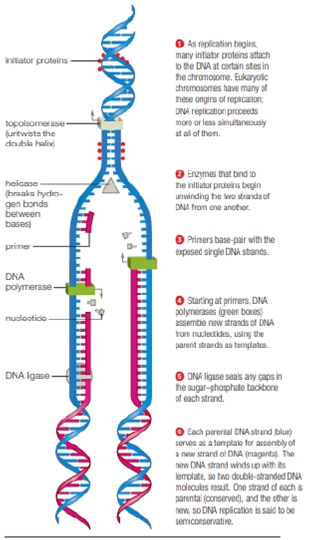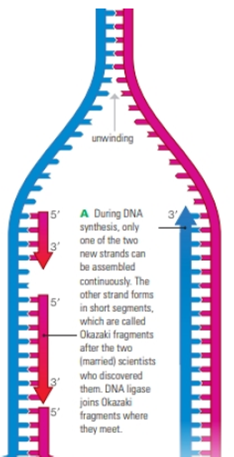
Concept explainers
Review Figures 8.12 and 8.13. In cells, the primers for DNA synthesis are short strands of RNA, so each newly-synthesized strand of DNA has a segment of RNA al its 5′ end. As replication proceeds, DNA polymerases remove these RNA segments and fill in the resulting gaps with DNA. However, the gaps at the very 5′ ends of the new strands cannot be filled in with DNA. Why not?

FIGURE 8.12 DNA replication.
Green arrows show the direction of synthesis for each strand. The Y-shaped structure where the DNA molecule is being unwound is called a replication fork.


FIGURE 8.13 Discontinuous synthesis of DNA.
This close-up of a replication fork shows that only one of the two new DNA strands is assembled continuously. The other is assembled in short segments.
Trending nowThis is a popular solution!

Chapter 8 Solutions
Biology: The Unity and Diversity of Life (MindTap Course List)
Additional Science Textbook Solutions
Loose Leaf For Integrated Principles Of Zoology
Laboratory Experiments in Microbiology (12th Edition) (What's New in Microbiology)
Microbiology with Diseases by Body System (5th Edition)
Biology: Life on Earth with Physiology (11th Edition)
Biology Illinois Edition (Glencoe Science)
- The following diagram represents a DNA molecule that is undergoing replication. Draw in the strands of newly synthesized DNA and identify (a) the polarity of the newly synthesized strands, (b) the leading and lagging strands, (c) Okazaki fragments, and (d) RNA primers. Origin 3' 5' 5' 3' Unwindirg Unwinding Originarrow_forwardConsider the following segment of DNA, which is part of a linear chromosome: LEFT 5’.…TGACTGACAGTC….3’ 3’.…ACTGACTGTCAG….5’ RIGHT During DNA replication, this double-strand molecule is separated from the right to the left into two single strands and the replisome is moving from the right to the left of the segment. The replisome is approaching to a chromosomal end on the left. Considering this left chromosomal end, if without telomerase, the newly synthesized daughter DNA of ___________ will be shortened? neither top or bottom strand both top and bottom strands the top strand the bottom strandarrow_forwarda) How is the lagging strand made in DNA replication? Include important enzymes and structures. How is this different from the synthesis of the leading strand? How is the structure of mRNA suited to its function? How is the structure of tRNA suited to its function? How is the structure of the nucleus suited to its function for protein synthesis?arrow_forward
- 5) In DNA replication, which of the following events happens during both leading and lagging strand synthesis? a. RNA primers help initiate DNA synthesis. b. Topoisomerase separates complementary strands of DNA. c. Ligase joins together multiple Okazaki fragments. d. DNA polymerase synthesizes a single, continuous strand of DNA. Explain WHY? 6) Suppose you are provided with an actively dividing culture of E. coli bacteria to which radioactive thymine has been added. What would happen if a cell replicates once in the presence of this radioactive base? a. One of the daughter cells, but not the other, would have radioactive DNA. b. Neither of the two daughter cells would be radioactive. c. All four bases of the DNA would be radioactive. d. DNA in both daughter cells would be radioactive. Explain WHY?arrow_forward1) The function of ligase is to seal nicks in the backbone of a DNA strand. The function of AP endonuclease is to create a nick in the backbone of a DNA molecule adjacent to an apurinic site, which allows DNA polymerase II access to the DNA to repair the damage and prevent a mutation resulting from the use of a damaged or erroneous strand of DNA as template during DNA replication. Why doesn't ligase simply seal up the nicks the AP endonuclease introduces before DNA pol II can do anything?arrow_forwardDescribe three (3) effects on DNA replication if DNA polymerase could build DNA in both directions – in both the 5’ to 3’ direction and the 3’ to 5’ direction.arrow_forward
- Assume a deletion occurs in a gene that encodes DNA polymerase I and no functional DNA polymerase I is produced. What will be the most likely consequence of this mutation? The DNA would not exist in a supercoiled state. There would be no RNA primers laid down. The DNA will not be able to unwind to initiate replication. The DNA strands would contain pieces of RNA. There would be no DNA replication on the leading or lagging strands.arrow_forward(d) Write down the sequences of the templates that would give the tetranucleotides shown in I and II. In each case, label the 5' and 3' ends and indicate which template base is used first. (e) What difference would it make to bidirectional DNA replication if both modes of chain extension were equally favourable? I IIarrow_forwardDeoxyribonucleoside triphosphates are the necessary and fundamental monomers for polymerization of DNA. However, DNA replication also requires ribonucleoside triphosphates. Why? More than one answer is correct. Question 8 options: new DNA chains are initiated on an RNA primer synthesized from ribonucleoside triphosphates by primase. DNA helicase uses the energy of ATP (a ribonucleoside triphosphate) to unwind the DNA double helix before DNA synthesis can occur. unlike DNA polymerase epsilon, DNA polymerase delta incorporates ribonucleotides into the growing polymer to synthesize the lagging strand ribonucleoside triphosphates are converted into deoxyribonucleoside triphosphates by DNA polymerase immediately before incorporation. DNA is first synthesized as RNA which is converted to DNA by removal of the 2'-OH (2' hydroxyl) from the pentose sugars in the backbone by DNA polymerase.arrow_forward
- The diagram depicts one strand of DNA at the end of a chromosome. This strand has been replicated and produced two fragments, as shown below. Which of the two gaps that exist, labeled (a) and (b), can be filled by DNA polymerase? Hint: remember the directionality requirement for DNA polymerase. a) gap (a) b) gap (b) c) both gaps (a) and (b) d) neither gaps (a) nor (b)arrow_forwardThe reaction in DNA replication catalyzed by DNA ligase isa) Addition of new nucleotides to the leading strandb) Addition of new nucleotide to the lagging strandc) Formation of a phosphodiester bond between the 3’-OH of one Okazaki fragment and the 5’-phosphate of the next on the lagging strandd) Base pairing of the template and the newly formed DNA strandarrow_forward(a) What will be the problem during DNA replication if the enzyme primase becomes non-functional? (b) In which step of the central dogma is the genetic information of DNA copied into new DNA strands? (c) Which of the following codons is a start codon: GCU, AUG or UGA?arrow_forward
 Human Heredity: Principles and Issues (MindTap Co...BiologyISBN:9781305251052Author:Michael CummingsPublisher:Cengage Learning
Human Heredity: Principles and Issues (MindTap Co...BiologyISBN:9781305251052Author:Michael CummingsPublisher:Cengage Learning
